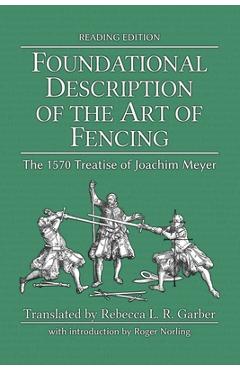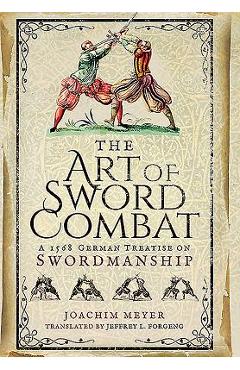Foundational Description of the Art of Fencing: The 1570 Treatise of Joachim Meyer (Reading Edition) - Joachim Meyer

Detalii Foundational Description of the Art
libris.ro
223.13 Lei
247.92 Lei
History
Joachim Meyer
Foundational Description of the Art - Disponibil la libris.ro
Pe YEO găsești Foundational Description of the Art de la Joachim Meyer, în categoria History.
Indiferent de nevoile tale, Foundational Description of the Art of Fencing: The 1570 Treatise of Joachim Meyer (Reading Edition) - Joachim Meyer din categoria History îți poate aduce un echilibru perfect între calitate și preț, cu avantaje practice și moderne.
Preț: 223.13 Lei
Caracteristicile produsului Foundational Description of the Art
- Brand: Joachim Meyer
- Categoria: History
- Magazin: libris.ro
- Ultima actualizare: 28-10-2025 01:22:05
Comandă Foundational Description of the Art Online, Simplu și Rapid
Prin intermediul platformei YEO, poți comanda Foundational Description of the Art de la libris.ro rapid și în siguranță. Bucură-te de o experiență de cumpărături online optimizată și descoperă cele mai bune oferte actualizate constant.
Descriere magazin:
In his short life, master cutler and Freifechter Joachim Meyer appears to have had quite a successful career as a fencing master, teaching craftsmen and nobility alike while also authoring at least four different fencing treatises (and possibly more). His works became renowned far outside of his own nation and were copied by other authors for over 100 years after his death. This book contains Dr. Rebecca Garber\'s entirely new translation of Meyer\'s longest and most developed treatise, Foundational Description of the Valiant, Knightly, and Noble Art of Fencing, published in 1570. It teaches complex and sophisticated methods for using all the typical weapons of his day, beginning with the two-handed sword prized by the tradition of Johannes Liechtenauer, then showing how traditional German fencing could be applied to the eastern European dusack and the Mediterranean rapier which had become popular as sidearms, and finally covering the dagger and polearms that were commonly used in the militias of the Imperial Free Cities. To aid in the study of this important work, the 61 elaborate Figures created by the circle of Tobias Stimmer have been broken up into individual pairs of fencers and placed inline in the text, and hundreds of footnotes have been added throughout. In addition, Roger Norling has provided an exhaustive, 110-page introduction to Meyer and the world that he inhabited. This book will prove to be an important resource for any student of medieval or early modern fencing.

Produse asemănătoare

Foundational Description of the Art of Fencing: The 1570 Treatise of Joachim Meyer (Reading Edition) - Joachim Meyer
![]() libris.ro
libris.ro
Actualizat in 28/10/2025
223.13 Lei

Foundational Description of the Art of Fencing: The 1570 Treatise of Joachim Meyer (Reading Edition) - Joachim Meyer
![]() libris.ro
libris.ro
Actualizat in 28/10/2025
334.73 Lei
Produse marca Joachim Meyer

Foundational Description of the Art of Fencing: The 1570 Treatise of Joachim Meyer (Reading Edition) - Joachim Meyer
![]() libris.ro
libris.ro
Actualizat in 28/10/2025
223.13 Lei

Foundational Description of the Art of Fencing: The 1570 Treatise of Joachim Meyer (Reading Edition) - Joachim Meyer
![]() libris.ro
libris.ro
Actualizat in 28/10/2025
334.73 Lei

The Art of Sword Combat: A 1568 German Treatise on Swordmanship - Joachim Meyer
![]() libris.ro
libris.ro
Actualizat in 08/04/2025
195.02 Lei